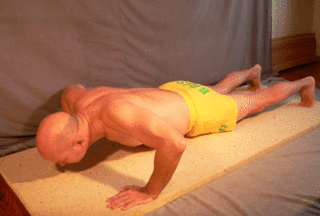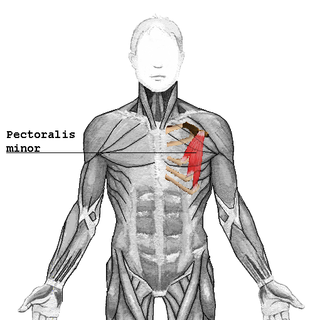This page is based on this
Wikipedia article Text is available under the
CC BY-SA 4.0 license; additional terms may apply.
Images, videos and audio are available under their respective licenses.

The bench press is an upper-body strength-training exercise that consists of pressing a weight upwards from a supine position. The exercise works the pectoralis major as well as the supporting chest, arm, and shoulder muscles such as the anterior deltoids, serratus anterior, coracobrachialis, scapulae fixers, trapezii, and the triceps. A barbell is generally used to hold the weight, but a pair of dumbbells can also be used.

A push-up is a common calisthenics exercise beginning from the prone position, or the front leaning rest position known in the military. By raising and lowering the body using the arms, push-ups exercise the pectoral muscles, triceps, and anterior deltoids, with ancillary benefits to the rest of the deltoids, serratus anterior, coracobrachialis and the midsection as a whole. Push-ups are a basic exercise used in civilian athletic training or physical education and commonly in military physical training. They are also a common form of punishment used in the military, school sport, or in some martial arts disciplines.

The pectoralis major is a thick, fan-shaped muscle, situated at the chest (anterior) of the human body. It makes up the bulk of the chest muscles and lies under the breast. Below the pectoralis major is the pectoralis minor, a thin, triangular muscle. In sports as well as bodybuilding, the pectoral muscles may colloquially be referred to as "pecs", "pectoral muscle" or "chest muscle" due to its being the larger and most superficial muscle in the chest area.

The pectoralis minor is a thin, triangular muscle, situated at the upper part of the chest, beneath the pectoralis major in the human body.

The anatomy of the domestic cat is similar to that of other members of the genus Felis.

Pectoral muscles are the muscles that connect the front of the human chest with the bones of the upper arm and shoulder.

In human anatomy, the infraspinatus muscle is a thick triangular muscle, which occupies the chief part of the infraspinatous fossa. As one of the four muscles of the rotator cuff, the main function of the infraspinatus is to externally rotate the humerus and stabilize the shoulder joint.

In human anatomy, the lateral thoracic artery is a blood vessel that supplies oxygenated blood to the lateral structures of the thorax and breast.

The lateral cord is a division of the brachial plexus. Cervical spinal nerves C5, C6, and C7 contribute to it.

The medial pectoral nerve arises from the medial cord of the brachial plexus and through it from the eighth cervical and first thoracic roots.

The lateral pectoral nerve arises from the lateral cord of the brachial plexus, and through it from the fifth, sixth, and seventh cervical nerves.

The clavipectoral fascia is a strong fascia situated under cover of the clavicular portion of the pectoralis major.

The sternalis muscle is an anatomical variation that lies in front of the sternal end of the pectoralis major parallel to the margin of the sternum. The sternalis muscle may be a variation of the pectoralis major or of the rectus abdominis.

The pectoral fascia is a thin lamina, covering the surface of the pectoralis major, and sending numerous prolongations between its fasciculi: it is attached, in the middle line, to the front of the sternum; above, to the clavicle; laterally and below it is continuous with the fascia of the shoulder, axilla, and thorax.

A Cable fly or Cable flye is a strength training exercise in which the hand and arm move through an arc while the elbow is kept at a constant angle. Flies are used to work the muscles of the upper body. Because these exercises use the arms as levers at their longest possible length, the amount of weight that can be moved is significantly less than equivalent press exercises for the same muscles .
Due to this leverage, fly exercises of all types have a large potential to damage the shoulder joint and its associated ligaments and the tendons of the muscles connecting to it. They should be done with caution and their effects first tested while using very light weights; which are gradually incremented after more strength is gained.

The dip or push-ups is an exercise used in strength training. Narrow, shoulder-width dips primarily train the triceps, with major synergists being the anterior deltoid, the pectoralis muscles, and the rhomboid muscles of the back. Wide arm training places additional emphasis on the pectoral muscles, similar in respect to the way a wide grip bench press would focus more on the pectorals and less on the triceps. Proper form is important to avoid putting undue stress on the wrists.
Targeted reinnervation enables amputees to control motorized prosthetic devices and to regain sensory feedback. The method was developed by Dr. Todd Kuiken at Northwestern University and Rehabilitation Institute of Chicago and Dr. Gregory Dumanian at Northwestern University Division of Plastic Surgery.













